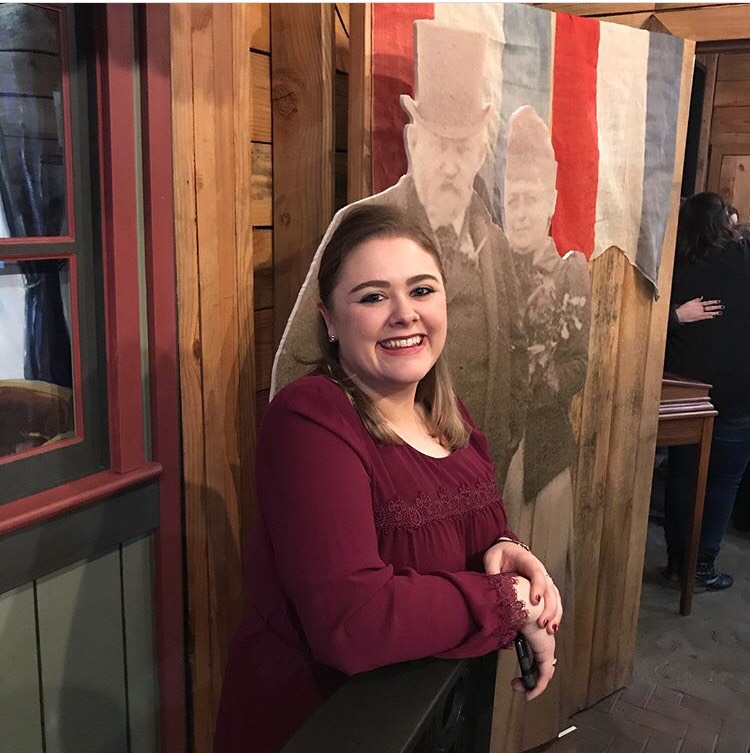A metal plate with intricate carvings representing the state of Colorado. An acrostic poem from Tucson, Arizona, complete with a cactus painted on the paper. Ribbons made of silk and wheat.
These are just a few of the items United States citizens gave President Benjamin Harrison during a 31 day 10,000 mile trek through the South and West. Now they are on display at the Benjamin Harrison Presidential Site in an exhibit curated by Allison Kraft, a museum studies grad student within the IU School of Liberal Arts at IUPUI.
“A Trip to Unify” tells the story of President Harrison’s 1891 journey. He gave 150 speeches to ignite the public’s patriotism. As Kraft read through the speeches she became inspired and wanted to show visitors each step of the president’s route. “I wanted them to experience those words as well,” she said.
Kraft, the Benjamin Harrison Presidential Site’s 2017 New Century Curatorial Fellow, fell in love with history and museums as a child when her grandparents took her to visit the Fithian House in Danville, Illinois. William Fithian was a local physician and politician who was also friends with Abraham Lincoln. Lincoln stayed in the house on visits while practicing law and also gave a speech from the balcony during his senate campaign. “It was the first place I had ever visited where someone of such historical significance had once been,” Kraft remembered. “I could not believe I was walking where Abraham Lincoln once walked.”
Before joining the museum studies program, Kraft majored in history and political science and earned a minor in art history at Purdue. She also began interning and working at various museums such as the Indiana State Museum, George Washington’s Mt. Vernon in Virginia, and the Eiteljorg Museum of Native Americans and Western Art in Indianapolis. This past summer she was the curatorial graduate intern at the Henry Ford Museum in Dearborn, MI. “[These experiences] opened my eyes to what it means to not only preserve artifacts but also the stories behind the artifacts,” she said.
“One of the great strengths of our program in the School of Liberal Arts is the relationships we have with area museums and the opportunities our students have to gain skills, work with museum professionals, and build their portfolios,” said Elizabeth Kryder-Reid, professor of anthropology and museum studies. “Our students build on the curriculum’s solid foundation in collections, education, and exhibits to tackle complex projects like this exhibit.”
“Not only do we get the chance to intern and work at these museums, but I’ve been to visit collection and conservation spaces within the museums with my classmates and professors to learn from professionals,” Kraft said. “Our professors have been incredible at providing us with these chances to learn beyond the classroom. Indianapolis has been absolutely incredible in the learning process and the experiences I have been fortunate to have. I’ve been so happy to go to school and work in this city.”
Kraft drew on those experiences and classroom learning as she began to build the Presidential Site exhibit. Working closely with curator Jennifer Capps, Kraft was responsible for choosing the artifacts on display, writing the narrative labels, and developing the exhibit layout.
She described the president’s journey as a whistle stop tour. Some stops were very brief. She compares the trip to modern campaigning. While patriotism was the overarching theme of the journey, President Harrison also spoke on regional topics like coming together as a country in the deep South and building a larger, stronger navy and expanding international trade and commerce in the West.
Presidential artifacts in the exhibit include an itinerary signed by all members of the presidential party, a ceremonial wooden button the first lady pressed to launch the second USS Monterey vessel, and many newspapers and photos documenting the trip.
“When visitors visit the exhibit it is my hope that they will not only learn more about this 10,000 mile journey but they leave feeling inspired, encouraged, and feel proud to be an American because some of these speeches are incredible and they speak with such patriotism,” Kraft said.
This is the second year of the New Century Curator Initiative partnership between the Benjamin Harrison Site and the museum studies program. “A Trip to Unify” runs through Oct. 2018.


